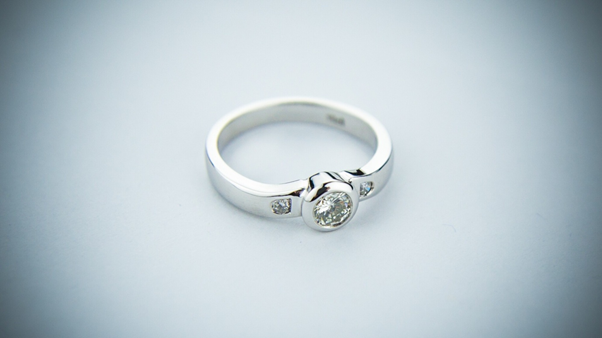
Diamonds are a girl’s best friend. At least, that’s how the song goes. But while they can be a great choice, they’re not for everyone. Younger generations are bucking traditions in terms of both cost and the types of stones for engagement rings.
Tradition is well and good, but it’s not the best fit for every couple. So this engagement ring stones guide will cover the conventional and some avant-garde options alike. Now let’s take a look at what engagement ring stones might be right for your happily ever after.
Diamonds: The Traditional Choice
To be fair to tradition, there is a reason that diamonds have become the standard for high-class jewelry, and engagement rings in particular.
They’re the strongest naturally occurring substance on earth, so there’s a bit of poetry to using them to represent your love. And there’s historical precedent. They’ve been the engagement stone of choice since 1477, when Austrian Archduke Maximillian commissioned a diamond ring for his fiance, Mary of Burgundy.
So it’s understandable if you’re dead-set on a diamond ring. But even in the diamond category, you have more choices than you may realize.
Natural Diamond
From the 15th century down to the present, couples have chosen naturally occurring diamonds to symbolize the bond of marriage. Like snowflakes, no two natural diamonds are quite the same. So you can be certain that your ring will be as special as your relationship.
Though the clear, colorless stud is the style most people imagine, it’s far from your only choice. They come in all manner of size, shape, and even color, with different cuts expertly designed to accentuate the stone’s natural qualities.
The trade-off is that since diamonds are quite rare you can count on them being the most expensive choice. And the diamond trade itself draws its share of objections.
Major diamond dealers are known to hoard diamonds, creating artificial scarcity and inflated retail prices. As with any material that needs to be mined, environmentalists object to the deleterious impact of harvesting them. And human rights advocates raise alarms over the extent to which the diamond trade fuels geopolitical conflicts.
You’ll want to weigh how important these factors are to you and your partner before you decide to invest in a natural diamond.
Lab-Grown Diamonds
As younger, more socially conscious consumers started to marry, they voiced a demand for a clean alternative to mined diamonds. And the market responded with the advent of lab-grown diamonds.
Lab-grown diamonds are identical to their natural counterparts in every way but require a fraction of the labor, resources, and expense to produce. And they can be grown to almost any size, shape, or color.
Understandably, a cheaper, more eco-friendly diamond that you can have tailored to your design proved to be a popular commodity. So popular that in 2021, Pandora announced they would discontinue the use of mined diamonds in their products altogether. When the world’s largest jeweler goes all-in on a trend, it’s probably safe to say it’s the way of the future.
Simulated Diamonds
Simulated diamonds are another lab-grown alternative to natural diamonds. What makes them different from their other lab-grown peers is that are not pure diamonds.
Simulated diamonds may include any number of materials to produce a desired color and clarity. Hence, they won’t match the chemical composition of the real thing. The trade-off is that they can cost as much as 80% than real diamonds, with the differences being imperceptible to anyone but an expert jeweler.
Alternative Types of Stones for Engagement Rings
Stones for engagement rings go well-beyond diamonds or even artificial diamonds.
There is a wealth of stones, some natural and others artificial, that are being embraced. Here are a few of the more popular ones.
Moissanite
Moissanite is a rare, naturally-occurring stone that was only discovered about a hundred years ago in an Arizona meteorite crater. They’re so much like diamonds that they were misidentified as such upon discovery. However, they tend to have depth and intensity unlike most diamonds, making them a prized choice for jewelry.
Because they are so scarce, most moissanite is lab-grown. This makes it an affordable choice, and it allows jewelers to create some breathtaking and unique pieces. These gothic rings studded with stones of black, red, and purple are good examples, and sure to delight any couple with a gothic sensibility.
Sapphire
For a natural, colored stone, look no further than sapphire.
Though we tend to imagine them as being uniformly blue, they come in a variety of rich colors. Some may even appear to change color based on the light.
If you want an alternative to diamonds, but still want a natural stone with traditional appeal, sapphire is the choice for you. Thanks to some breathtaking examples like The Heart of the Ocean and Kate Middleton’s engagement ring, they’re currently enjoying a surge in popularity.
Ruby
It’s not hard to see the symbolic appeal of a ruby engagement ring. These intense stones embody love, courage, passion, and protection while making a striking visual statement.
Though they’re most often a deep crimson, their color can vary depending on where they’re sourced from. Red, pink, and even violet are all common variants.
Perfect Weddings Demand the Perfect Engagement Ring Stones
You and your partner are both unique souls, unlike any two others in the world. And to celebrate how special it is that you should find each other, you deserve a ring that symbolizes your exceptional bond. By considering all the types of stones for engagement rings out there, you’re sure to find one that you can cherish for a lifetime.
But of course, these stones aren’t exclusive to engagement rings. If there’s one that catches your eye but isn’t quite right for that particular ring, check out our other jewelry writing for ideas on how to match that stone with a unique design.

Comments are closed.